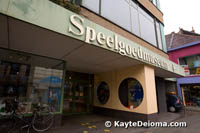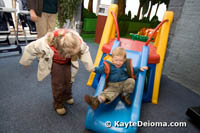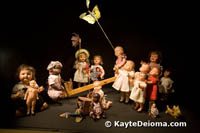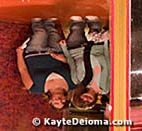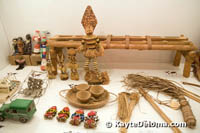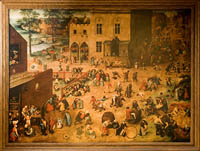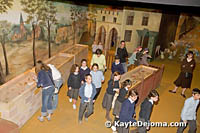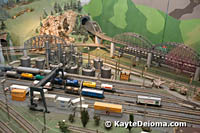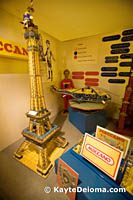story and photos by Kayte Deioma
 There’s something irresistible about a city as devoted to comic strips as Brussels. There are no less than four museums devoted to the history, the creators and the production of the bande dessinée or comic strip. There are over a dozen stores specializing in comic books and merchandise, and even a comic-themed bar. As if that weren’t enough, you can see larger than life comic statues and murals of some of the most popular characters all around town.
There’s something irresistible about a city as devoted to comic strips as Brussels. There are no less than four museums devoted to the history, the creators and the production of the bande dessinée or comic strip. There are over a dozen stores specializing in comic books and merchandise, and even a comic-themed bar. As if that weren’t enough, you can see larger than life comic statues and murals of some of the most popular characters all around town.
 It’s not the American classics like Peanuts and Superman, or Japanese animé, but home-grown creations like Tintin, the Smurfs and hundreds of others that have filled the pages of Belgian newspapers, magazines and comic books for a century. Belgium, as it turns out, has more comic strip authors per square mile than anywhere else in the world.
It’s not the American classics like Peanuts and Superman, or Japanese animé, but home-grown creations like Tintin, the Smurfs and hundreds of others that have filled the pages of Belgian newspapers, magazines and comic books for a century. Belgium, as it turns out, has more comic strip authors per square mile than anywhere else in the world.
Your jumping off point for exploring the Belgian passion for comics should be the Centre Belge de la Bande Dessinée, the Belgian Center for Comic Strip Art. The museum opened in 1989 in an Art Nouveau warehouse designed by the famed architect Victor Horta. The museum has taken on the secondary mission of providing information on Belgian Art Nouveau with a dedicated gallery on the entry level, next to the Horta Brasserie and Restaurant.
 The strategically placed comic strip characters look a bit out of place in the elegant lobby with its stone columns and wrought iron grillwork supporting a frosted glass ceiling embellished with stained glass ribbons around the edges. Through an opening in the center you can see the upper floors and skylight above. Along with the restaurant and Art Nouveau gallery, a gift shop, reading room and research center surround the atrium. A marble-based lamp post stands in the center, and a wide stairway leads up to the ticket desk and official entrance to the museum.
The strategically placed comic strip characters look a bit out of place in the elegant lobby with its stone columns and wrought iron grillwork supporting a frosted glass ceiling embellished with stained glass ribbons around the edges. Through an opening in the center you can see the upper floors and skylight above. Along with the restaurant and Art Nouveau gallery, a gift shop, reading room and research center surround the atrium. A marble-based lamp post stands in the center, and a wide stairway leads up to the ticket desk and official entrance to the museum.
Although some of the temporary exhibits include English captions, the permanent displays usually do not. If you don’t speak French or Dutch, you’ll want to ask for the printed English Guide to carry along with you, or call ahead to hire an English speaking tour guide.
 The first hall behind the ticket counter introduces you to the original technologies used to create and print comic strips as well as the team of writers, artists, colorists, letterers and printers whose efforts go into producing the final product. Publishers, marketers and merchandisers have their roles as well.
The first hall behind the ticket counter introduces you to the original technologies used to create and print comic strips as well as the team of writers, artists, colorists, letterers and printers whose efforts go into producing the final product. Publishers, marketers and merchandisers have their roles as well.
You are taken through the process with examples of each stage of production. Paper, pencils, pens, watercolors, paint brushes, felt-tip markers, and drawing templates initiate you to the tools of the trade. A story board with inky cat paw prints and crumpled rejected pages on the floor take you into the artists’ studio.
 In the Espace Saint Roche gallery, the museum presents rotating exhibits from their collection of over 7,000 original comic strip drawings. On the opposite side, Comic Strips in Motion shows the evolution from comic strips to animated cartoons from Little Nemo, the first animated cartoon in 1911, to modern digital animation technology.
In the Espace Saint Roche gallery, the museum presents rotating exhibits from their collection of over 7,000 original comic strip drawings. On the opposite side, Comic Strips in Motion shows the evolution from comic strips to animated cartoons from Little Nemo, the first animated cartoon in 1911, to modern digital animation technology.
On the second level you meet the pioneers of Belgian comics through 1960 including the country’s most famous bande dessinée creator Hergé (Georges Remi), creator of Tintin. The intrepid journalist’s adventures have been translated and published around the world since 1929. The series has been made into many animated episodes, and Steven Spielberg recently bought the rights to make a Tintin movie.
Additional presentations highlight the contribution of each artist, scriptwriter and publisher to the evolution of French and Dutch language comic strips, comic strip magazines and comic books in Belgium.
 The Smurf Museum exhibit tells the tale of the “intrepid Professor De Saeger” who found the mystical land of the little blue “Schtroumphs” and brought back these artifacts to prove their existence. The display includes original line drawings and paints and well as Smurf toys and a “scale model of a Smurf dwelling.”
The Smurf Museum exhibit tells the tale of the “intrepid Professor De Saeger” who found the mystical land of the little blue “Schtroumphs” and brought back these artifacts to prove their existence. The display includes original line drawings and paints and well as Smurf toys and a “scale model of a Smurf dwelling.”
Interesting temporary shows bring an international perspective into the otherwise Belgian-focused museum. The touring exhibits are more likely to have English captions as well. In summer 2008, the museum will be celebrating the 50th anniversary of the Smurfs with a special exhibition.
 The printed English guide is invaluable for understanding the significance of the permanent collection if you don’t read French or Dutch. If you want to get the most out of the museum but you don’t want to do all that reading, you might want to hire an English-speaking guide. They are available by appointment only and charge a flat rate for up to 25 people for a one and a half hour tour. Guides are also available to take you on a walking tour of the outdoor Comic Strip Trail.
The printed English guide is invaluable for understanding the significance of the permanent collection if you don’t read French or Dutch. If you want to get the most out of the museum but you don’t want to do all that reading, you might want to hire an English-speaking guide. They are available by appointment only and charge a flat rate for up to 25 people for a one and a half hour tour. Guides are also available to take you on a walking tour of the outdoor Comic Strip Trail.
The Belgian Comic Strip Center
20 rue des Sables – 1000 Brussels
Open every day (except Monday) from 10 am to 6 pm
www.comicscentre.net
Phone: 32 (0) 2 219 19 80
Email: visit@comicscentre.net

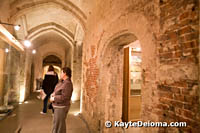 The saying “One man’s trash is another man’s treasure,” could be the motto of the field of archaeology, where a broken pottery shard, a flint or a chicken bone can elicit more excitement than discovering gold. The archaeologists hit the jackpot in Brussels when new construction in 1995 revealed that the lower levels of the Royal Palace on Coudenberg Hill which burned down in 1731, were left largely intact when they flattened the area in 1774 to build a new royal compound. After a six-year excavation, the restored underground passages were opened to the public in 2001.
The saying “One man’s trash is another man’s treasure,” could be the motto of the field of archaeology, where a broken pottery shard, a flint or a chicken bone can elicit more excitement than discovering gold. The archaeologists hit the jackpot in Brussels when new construction in 1995 revealed that the lower levels of the Royal Palace on Coudenberg Hill which burned down in 1731, were left largely intact when they flattened the area in 1774 to build a new royal compound. After a six-year excavation, the restored underground passages were opened to the public in 2001.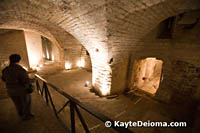 and a street that ran along the outside of the palace give a glimpse of the support system for the Archdukes, and Duchesses, Princes and Emperors who resided here.
and a street that ran along the outside of the palace give a glimpse of the support system for the Archdukes, and Duchesses, Princes and Emperors who resided here.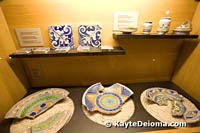 Part of the chapel cellar now houses an exhibit of the artifacts discovered in the excavation. 16th century chamber pots, book clasps and random utensils were recovered from the cesspools. Heater tiles and a plethora of architectural remains and everyday items were found in the rubble of the Grand Hall. One display case contains a colorful collection of broken bits of 16th century majolica architectural tiles, dinner plates and apothecary vessels.
Part of the chapel cellar now houses an exhibit of the artifacts discovered in the excavation. 16th century chamber pots, book clasps and random utensils were recovered from the cesspools. Heater tiles and a plethora of architectural remains and everyday items were found in the rubble of the Grand Hall. One display case contains a colorful collection of broken bits of 16th century majolica architectural tiles, dinner plates and apothecary vessels.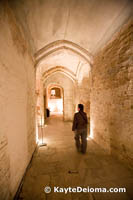 palace’s most famous resident, Charles V, the simultaneous King of Spain, Emperor of Germany and Sovereign of the Low Countries, came to be first emancipated and later abdicated his throne in Brussels.
palace’s most famous resident, Charles V, the simultaneous King of Spain, Emperor of Germany and Sovereign of the Low Countries, came to be first emancipated and later abdicated his throne in Brussels.